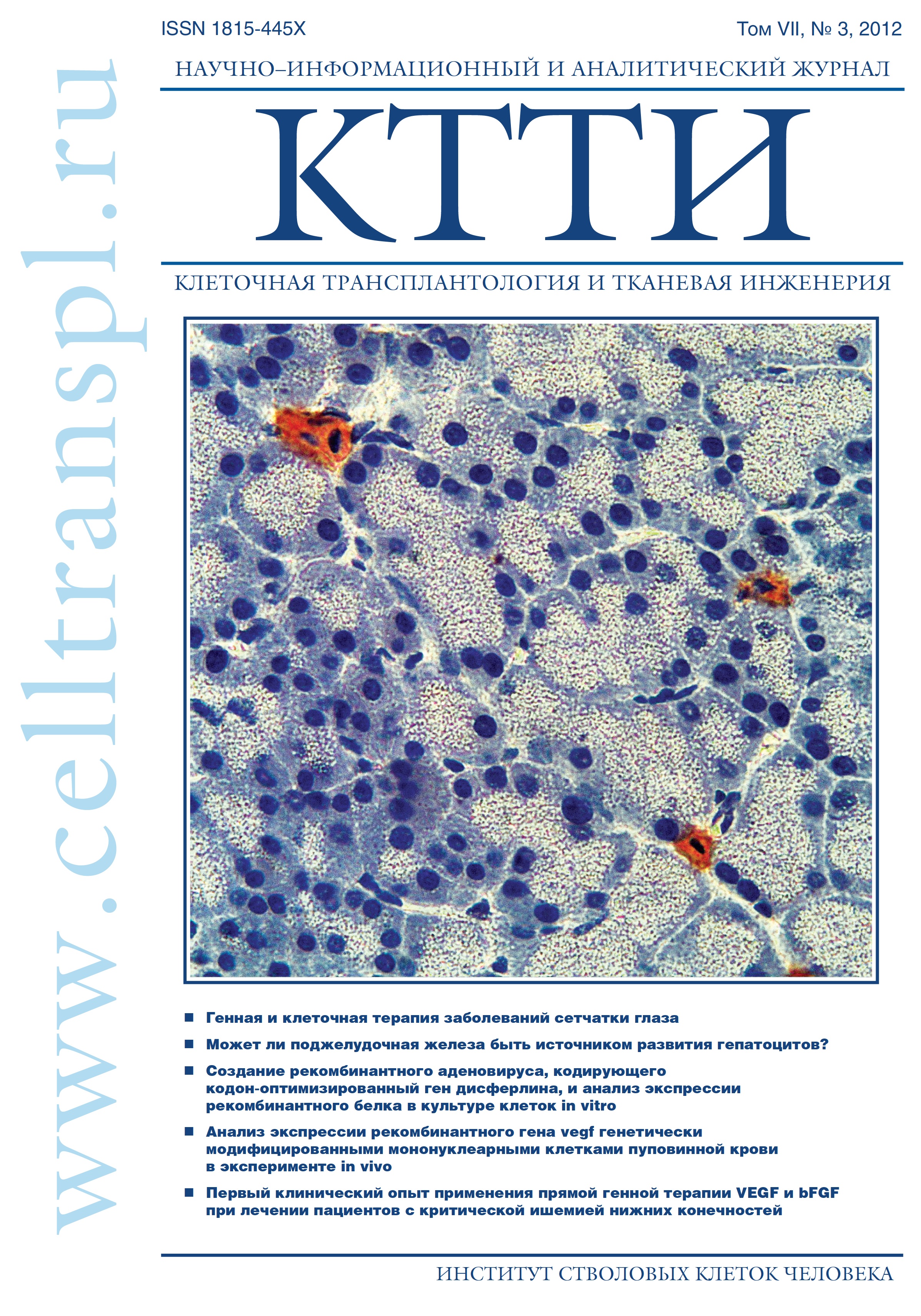Formation of the recombinant adenovirus encoding codon-optimized dysferlin gene and analysisof the recombinant protein expression in cell culture in vitro
- Authors: Starostina IG1, Solovyeva VV1, Shevchenko KG2, Deev RV2, Isaev AA2, Rizvanov AA1
-
Affiliations:
- Kazan (Volga region) federal university, Kazan
- Human Stem Cells Institute, Moscow
- Issue: Vol 7, No 3 (2012)
- Pages: 25-28
- Section: Articles
- URL: https://genescells.ru/2313-1829/article/view/121567
- DOI: https://doi.org/10.23868/gc121567
- ID: 121567
Cite item
Abstract
associated with aberrant expression and/or function of
dysferlin protein in skeletal muscle, which is caused by
mutations in the dysf (dystrophy-associated fer-1-like, DYSF)
gene. Because of the large size of the codon-optimized dysf
coding region (6243 bp), adenoviral vectors are suitable for
the creation of genetic constructs, which are capable of
delivering a large amount of recombinant genetic information
into both dividing and non-dividing cells, as well as provide a
high level of transgene expression.
We generated a recombinant adenovirus serotype
5 encoding a codon-optimized gene for human dysferlin (Ad5-
Dysf) and analysed recombinant protein expression in vitro in
HEK-293T cell line.
About the authors
I G Starostina
Kazan (Volga region) federal university, KazanKazan (Volga region) federal university, Kazan
V V Solovyeva
Kazan (Volga region) federal university, KazanKazan (Volga region) federal university, Kazan
K G Shevchenko
Human Stem Cells Institute, MoscowHuman Stem Cells Institute, Moscow
R V Deev
Human Stem Cells Institute, MoscowHuman Stem Cells Institute, Moscow
A A Isaev
Human Stem Cells Institute, MoscowHuman Stem Cells Institute, Moscow
A A Rizvanov
Kazan (Volga region) federal university, KazanKazan (Volga region) federal university, Kazan
References
- Bushby K.M. Making sense of the limb-girdle muscular dystrophies. Brain 1999; 122: 1403-20.
- Liu J., Aoki M., Illa I. et al. Dysferlin, a novel skeletal muscle gene, is mutated in Miyoshi myopathy and limb girdle muscular dystrophy. Nat. Genet. 1998; 20(1): 31-6.
- Bashir R., Strachan T., Keers S. et al., A gene for autosomal recessive limb-girdle muscular dystrophy maps to chromosome 2p. Hum. Mol. Genet. 1994; 3(3): 455-7.
- Therrien C., Dodig D., Karpati G. et al. Mutation impact on dysferlin inferred from database analysis and computer-based structural predictions. J. Neurol. Sci. 2006; 250(1-2): 71-8.
- Fujita E., Kouroku Y., Isoai A. et al., Two endoplasmic reticulumassociated degradation (ERAD) systems for the novel variant of the mutant dysferlin: ubiquitin/proteasome ERAD(I) and autophagy/ lysosome ERAD(II). Hum. Mol. Genet. 2007; 16(6): 618-29.
- Davis D.B., Doherty K.R., Delmonte A.J. et al. Calcium-sensitive phospholipid binding properties of normal and mutant ferlin C2 domains.
- J. Biol. Chem. 2002; 277(25): 22883-8.
- Bansal D., Miyake K., Vogel S.S. et al., Defective membrane repair in dysferlin-deficient muscular dystrophy. Nature 2003; 423(6936): 168-72.
- Lennon N.J., Kho A., Bacskai B.J. et al., Dysferlin interacts with annexins A1 and A2 and mediates sarcolemmal wound-healing. J. Biol. Chem. 2003; 278(50): 50466-73.
- Bashir R., Britton S., Strachan T. et al. A gene related to Caenorhabditis elegans spermatogenesis factor fer-1 is mutated in limbgirdle muscular dystrophy type 2B. Nat. Genet. 1998; 20(1): 37-42.
- Aoki M., Liu J., Richard I. et al. Genomic organization of the dysferlin gene and novel mutations in Miyoshi myopathy. Neurology 2001; 57(2): 271-8.
- Guglieri M., Magri F., D'Angelo M.G. et al. Clinical, molecular, and protein correlations in a large sample of genetically diagnosed Italian limb girdle muscular dystrophy patients. Hum. Mutat. 2008; 29(2): 258-66.
- Vetrini F., Ng P. Gene therapy with helper-dependent adenoviral vectors: current advances and future perspectives. Viruses 2010; 2(9): 1886-917.
- Dudley R.W., Lu Y., Gilbert R. et al. Sustained improvement of muscle function one year after full-length dystrophin gene transfer into mdx mice by a gutted helper-dependent adenoviral vector. Hum. Gene Ther. 2004; 15(2): 145-56.
- Jiang Z., Feingold E., Kochanek S. et al. Systemic delivery of a high-capacity adenoviral vector expressing mouse CTLA4Ig improves skeletal muscle gene therapy. Mol. Ther. 2002; 6(3): 369-76.
- Roth J.A., Cristiano R.J. Gene therapy for cancer: what have we done and where are we going? J. Natl. Cancer Inst. 1997; 89(1): 21-39.
- Cohen S.N., Chang A.C., Hsu L. Nonchromosomal antibiotic resistance in bacteria: genetic transformation of Escherichia coli by R-factor DNA. PNAS USA 1972; 69(8): 2110-4.
- Sambrook J., Russell D.W. Molecular cloning: a laboratory manual. 3 ed. Cold Spring Harbor Laboratory Press; 2001.
- Laemmli U.K. Cleavage of structural proteins during the assembly of the head of bacteriophage T4. Nature 1970; 227(5259): 680-5.
- Graham F.L., Smiley J., Russell W.C. et al. Characteristics of a human cell line transformed by DNA from human adenovirus type 5. J. Gen. Virol. 1977; 36(1): 59-74.
- Harrison T., Graham F., Williams J. Host-range mutants of adenovirus type 5 defective for growth in HeLa cells. Virology 1977; 77(1): 319-29.
Supplementary files










